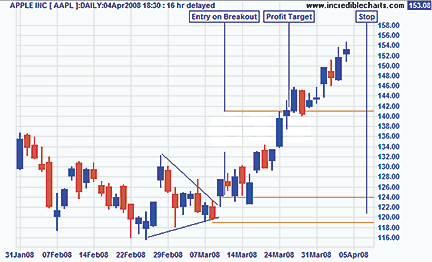Establishing Risk And Reward
Here's how you can manage risk when you're trading specific chart patterns.
Trading with profit targets is a sensible way to approach the markets. Doing so allows you to establish risk-reward ratios before making a trade. You can then accept or reject a trade based on how much reward you can reasonably expect based on the risk you have established for the trade.
This is a powerful process. It ensures that a trader has established the risk of each trade before taking that trade. Before placing a trade, you should calculate the maximum loss you can take. The risk limits based on technical analysis will let you know if you should not be in the market in the direction you have chosen.
Once the risk is known, a trader can then determine if a trade is worth taking based on what profit can be expected from the trade. Many traders have touted that there should be at least a 3-to-1 reward-to-risk ratio for each trade. While this is a good rule of thumb and may service many traders' needs, it is not an all-encompassing rule. Since each trader has a different style and trades over different time frames, it would be impossible to establish a set risk and reward rule for all traders.
Each trader must establish a risk-reward ratio based on their trading performance. That said, the 3-to-1 reward-to-risk ratio allows the trader freedom to take losses and still be profitable as long as risk is kept in check and trades are allowed to reach the profit targets as often as possible. In this way, the trader can be wrong three times, right only once, and still break even.

In most cases, the minimum of a 3-to-1 reward-to-risk ratio would be the prudent choice for most traders. Therefore, this article will focus on establishing at least a 3-to-1 reward-to-risk ratio, keeping losses as small as possible while attempting to maximize the largest reasonable gains.
PROFIT TARGETS USING CHART PATTERNS
In order to attain at least a 3-to-1 ratio, it is important to first know when to enter a trade. To do this you must determine the types of trades in which profit targets will be most suited. Profit targets are most often used in conjunction with common (and some not so common) chart patterns. Chart patterns are seen on long- and short-term charts and show levels at which you can expect to see reasonable and predictable price movements. Of course, no method is 100% exact, but chart patterns work because when a pattern completes, it generates a reaction from all traders involved in the trade.
...Continued in the November issue of Technical Analysis of STOCKS
& COMMODITIES
Excerpted from an article originally published in the November 2008 issue of Technical Analysis of STOCKS & COMMODITIES magazine. All rights reserved. © Copyright
2008, Technical Analysis, Inc.
Return to November 2008 Contents